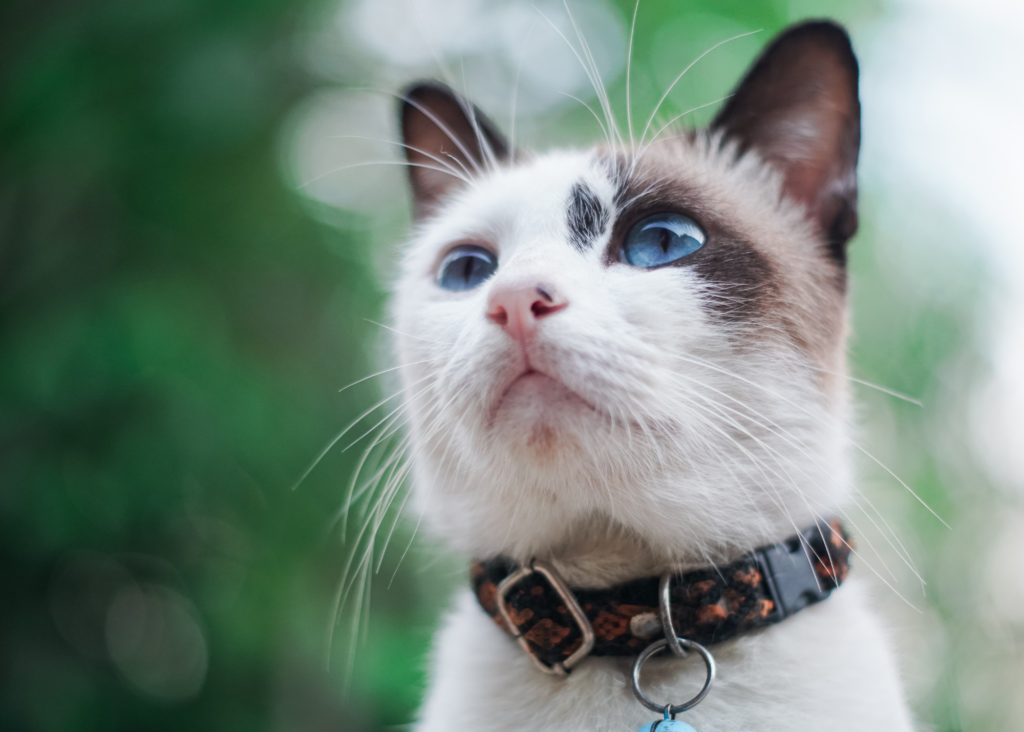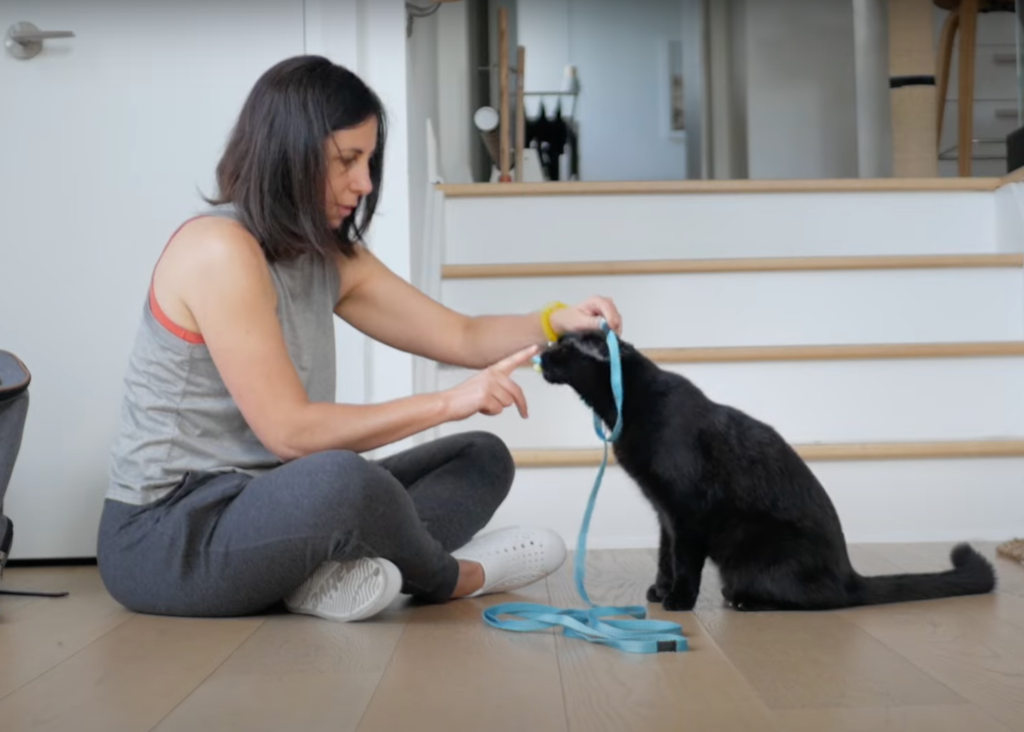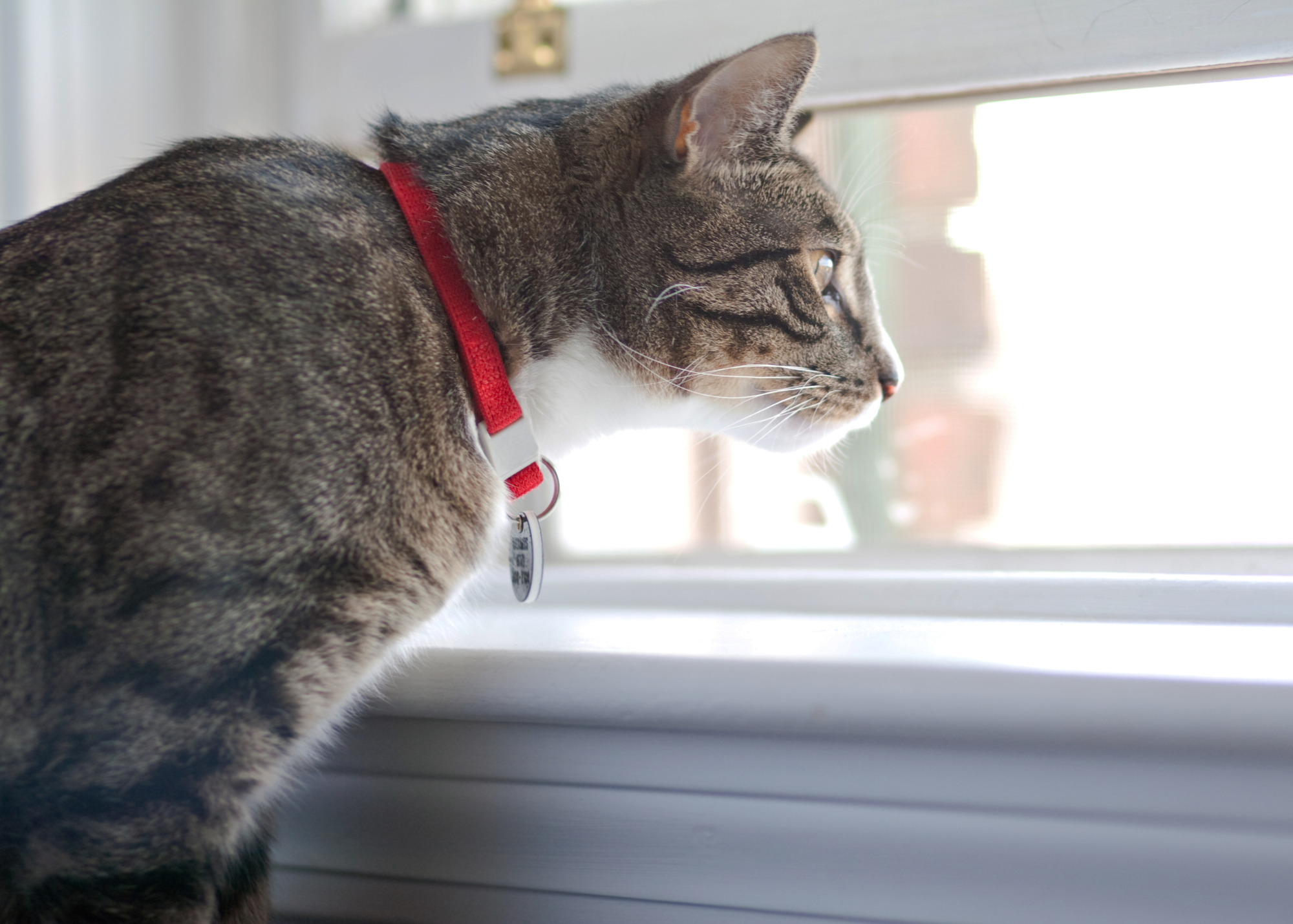Cat Collar Training: How and Why to Do It
Wearing a collar is an essential skill for all cats. Cat collar training is important for:
- Outdoor cats – cats that roam free
- Cats that go out on a harness and leash
- Cats at risk of door dashing. If indoor-only cats are at risk of getting outside, they should wear a collar.
- Cats experiencing a change in their environment that puts them at risk, including traveling, moving, vet visits, and being cared for by a house sitter.
- Cats who may need to wear a cone one day because of treatment.
That being said, getting your cat to actually wear a collar can sometimes be easier said than done. Not all cats will take to wearing a collar right away, and putting a collar on your cat is not a set it and forget it type of situation. Cat collar training is essential to ensure your cat is successful at wearing a collar.
Should I Train My Cat to Wear a Collar?
The short answer is, “Yes!” Whether you have an outdoor cat, indoor-only cat, or walk your cat on a leash (like I do), all cats will likely need to wear a collar at some point in time. For some, wearing a collar is 100% mandatory.
Every outdoor cat must wear a collar.
While we advocate for every feline companion to be an indoor cat (unless going outside on a harness and leash), many cat owners still let their cats roam free. For these outdoor cats, there is a real danger in getting lost. It’s easy to mistake an outdoor cat not wearing collar as a stray cat.
Only 74% of lost cats are reunited with their families, so we should be doing everything possible to improve that statistic. Wearing a well-fitting collar, attaching a GPS tracker to the collar, and getting your cat microchipped are all ways to keep your outdoor cat safe. It also allows people to contact you if your cat is injured, gets in a fight, or is being a nuisance in your neighbor’s garden.
Cats who go out on a harness and leash MUST wear a collar.
There is no such thing as an “escape-proof” harness, so any cat who goes out on a harness and leash should also wear a collar with a tracking device. In an emergency situation, if your cat slips out of the their harness, you will still be able to find them.
Indoor cats who door dash MUST wear a collar.
It is a good idea for cats who are at risk of door dashing to wear a collar. Accidents happen, and if your cat gets outside, having a collar on them (with a tracking device) will help you recover your cat.
Cats who are being put at risk due to a change in environment MUST wear a collar.
We’ve all heard stories about cats moving and getting lost. When you change your cat’s environment, you can’t predict all the possible dangers in a new setting. For example, doors or windows that don’t shut properly.
Having someone take care of your cat when you go away also puts your cat at risk because they don’t know all of your cat’s behaviors – for example, if they door dash.

What’s the Best Cat Collar?
Finding the right collar involves asking two questions.
- Is it the right fit for your cat’s neck so it won’t get caught in anything (for example, their limb if they scratch)?
- Will it stay on?
Does my cat need a breakaway collar?
A breakaway cat collar is one that has a buckle that will snap open when pulled hard enough. This is one of the safety features more cat owners look for in collar selection. While breakaway collars serve an important purpose (relieve people of the worry their cat is in danger of the collar getting caught somewhere), a problem arises when the collar is too sensitive and falls off if the cat scratches. If a cat owner has to reapply a collar often, they may give up eventually.
During an introductory process, it’s important to watch the sensitivity of a breakaway collar.
If you opt for a breakaway collar you should do a testing period indoors first to ensure it stays on. My cat Jones wears a breakaway collar, and it’s never come off.
Stay away from elastic collars.
Elastic stretch cat collars have a piece of elastic in them that allows them to stretch. Though they may seem like a good idea, they are actually quite unsafe. In a study done to determine the percentage of cats still wearing collars after a 6 month period, all the participating cats who got their collars stuck on an object were wearing elastic stretch collars. The study found that these types of collars were most likely to stretch out and become loose, making them more likely to get caught on other objects.
Select a collar that supports a tracking device.
While it’s important to select a safe collar (one that won’t get caught in anything), the best way to keep your cat safe is with a tracking device. A tracking device gives your cat the protection that, in an emergency, you can locate them. If your cat’s collar falls off too easily, not only do they lose their ID, they also lose their tracker.
How to Fit Your Cat for a Collar
To ensure your cat is as safe as possible while wearing their collar, you want to make sure their collar has been properly fitted. A collar that is too tight will be uncomfortable and can put pressure on their sensitive neck area.
A collar that is too loose is more likely to come off, and it can also be dangerous. If it’s too loose, your cat could slip a leg through and get stuck. They could also get their bottom jaw stuck in it.
When selecting your cat’s collar size, you can measure around their neck with a flexible tape measure. If you don’t have a flexible tape measure, you can use a piece of string and cut it to the needed length, then measure the string with a ruler. You should be able to fit 2 fingers between your cat’s neck and their collar.
Don’t set it and forget it.
For your cat’s safety, it is important to check your cat’s collar on a regular basis to make sure it is still has proper fit and that the tracking device is securely attached.
Cat Collar Training Steps
While there are definitely some cats who will immediately accept wearing a collar, that is not always the case. If you have a cat who is uncomfortable wearing a collar and manages to always scratch it off, they CAN be trained to willingly accept it.
Follow the clicker training steps below for the best chance of success with your feline companion. The key is to take things slow and use positive reinforcement (i.e. treats)! There is also a video tutorial down below.
Phase 1
- Create a large loop using one of three methods:
1) The handle of a leash
2) The clasp of a leash to create a slip. Be careful using this method – make sure your cat can always pull out and the loop won’t tighten.
3) A collar loosened all the way (if your cat’s collar will loosen enough) - With food in your hand, draw your cat’s head through the loop.
- When your cat’s head is on the other side of the loop, click and feed them the treat with the loop resting on their back. Since both your hands are occupied, and you can’t hold the clicker, you can make a clicking sound with your mouth.
- Continue to feed your cat as you remove the loop. Putting their head in something and taking it out are equally scary processes.
- Once your cat is confidently following the food through the loop, switch to a finger target or target stick and stop using the food lure.

Phase 2
Your cat should be well-versed in putting their head through the loop from Training Phase 1 before moving on to the next phase of training. If you’ve been using your cat’s leash handle thus far, you can switch to using the slip or loosened collar now that your cat is feeling more confident.
- Present the loop to your cat as a cue and wait for them to put their head through. If they don’t do it independently, help them with the hand signal after one to two seconds. Repeat this process until your cat sees the loop as the signal and will automatically put their head through.
- Once the looped leash is resting on your cat’s back, practice opening the clasp to release the loop. This will help your cat get comfortable with removing equipment.
- Practice opening and closing the clasp resting on your cat’s back to get them comfortable with your hands behind their neck. If you aren’t comfortable using the slip for this, you can use a leash and pretend to “fasten” and unfasten” it around your cat’s neck.
- Widen the distance between your hands to mimic the opening and closing of a collar on your cat’s neck.
- Now you’re ready to introduce your cat to their collar! Have them practice wearing it for prolonged periods to get comfortable with it.
Cat Collar Training Video Tutorial
Need further help with your cat collar training? Join the Cat School Classroom to access the step-by-step training videos!
Cat Collar FAQs
- What should I look for in a cat collar? A cat collar should be thin and lightweight. 3/8″ – 1/2″ width is best. You can easily find adjustable cat collars at your local pet store, or you can find places online to order a custom-length collar. A custom collar is nice because it is a bit less bulky than an adjustable one.We do NOT recommend elastic collars.
- Should I microchip my cat if they already wear a collar? Yes! Though collars are a great form of quick identification should a stranger come across your kitty, a microchip adds an extra level of loss-prevention. For example, if your cat manages to slip out of their collar, they’d still have a microchip they can be identified by.
- Does my cat need to wear a collar if they are already microchipped? Yes! Microchips are great and we definitely advocate for them, but they require a person to take your cat to a veterinarian or animal shelter that has a chip scanner. If your cat wears a collar with up-to-date ID tags, a person can quickly and easily identify your cat and give you a call.
- Does my indoor cat need to wear a collar? Yes! As mentioned in the article, indoor cats can accidentally slip outside and become lost. If you decide not to put a collar on your indoor cat at all times, you should at least have them wear one in the following circumstances:
- Unexpected visitors come to your home (e.g., a repair person)
- You’re taking your cat to the vet
- You’re taking a trip or moving
- A house- or pet-sitter comes over to care for them
- They are doing fire alarm testing in your apartment building
- Does my outdoor cat need to wear a collar? Yes! If your outdoor cat is wearing a collar, they will be less likely to be identified as a stray. If a neighbor sees your cat has a collar, they will know your cat has a home.It is not uncommon for outdoor cats to have multiple homes that feed them because neighbors see the cat and think they are a stray. Eventually your cat may even stop coming home because they’re getting cared for (or even brought inside) somewhere else. A collar will help prevent that.We also recommend putting a bell on an outdoor cat’s collar to alert any prey animals of your cat’s presence.(If you have an outdoor cat, we also recommend reconsidering their situation. Outdoor cats are more prone to injuries, sickness, and death. They can still enjoy the wonder of the outdoor world on a harness and leash, which ensures a safer experience and allows for great bonding between you and your feline companion.)
- When should my cat start wearing a collar? Cats can begin wearing collars at any age. Though it’s typically easier to train a kitten than an adult cat or senior cat, it’s never too late.If you have a new kitten, we recommend beginning your collar training as soon as possible. For safety reasons, just make sure your kitten only wears their collar under supervision, as they might not be strong enough to detach a breakaway buckle on their own if they were to get snagged on something.
Resources:

